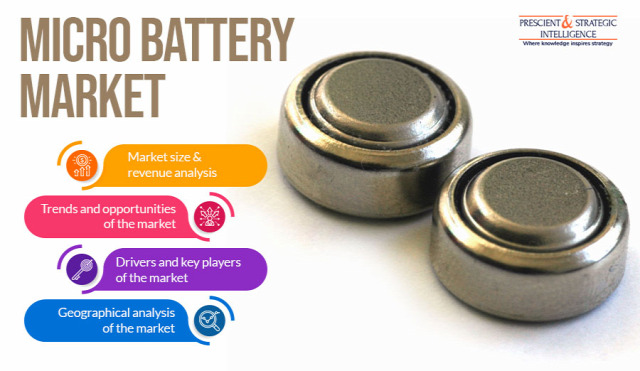In 2023, the micro battery market held a value of USD 489.3 million, experiencing a compound annual growth rate (CAGR) of 23.3% from 2024 to 2030. This growth is anticipated to propel the market to USD 2,060.2 million by 2030. This can be credited to the growing utilization of wearable devices and improvements in tech like artificial intelligence and the Internet of Things along with robotics and automation.
The introduction and development of smart wearable devices have been key propelling forces for the development of the industry. Such devices, including fitness trackers, smart wearables, and health monitoring systems, need small size and power-efficient power sources to work while still being visually pleasing and lightweight.

These comprise lithium-ion batteries, in particular, offering a win-win situation that combines high-power density with extending lifecycle and a compact size. As the need for wearable devices continues to expand, the micro battery industry will also continue to advance.
Lithium batteries are the most popular type of battery, accounting for roughly 40% of the market in 2023. This is because they store more energy than other batteries in a smaller and lighter package, making them perfect for powering small electronics. They can also function in a wide range of temperatures, have a slow discharge rate, charge quickly, and have a high voltage. Additionally, they can be recycled.
Micro batteries having a capacity of 10–100 mAh grips the largest share in the industry. The growing occurrence of these batteries in the microelectronic industry is credited to their multipurpose range offering power to numerous applications, such as remote controls, small electronic devices, wearables, IoT sensors, and key fobs; lengthier runtime; compacted size; and balanced energy density.
During the projection period, the rechargeable micro batteries category under the rechargeability segment is projected to experience an advanced compound annual growth rate. This development can be credited to some of the consequent aids such as reusability.
The main components of consumer electronics are micro-batteries, and this category has the largest market share. In addition, there is a growing need for efficient and reliable power solutions around the world. To power a wide range of devices, such as smartphones, cameras, and remote controls, these batteries are widely utilized in the consumer electronics sector.
In addition, micro batteries are used to power wireless earbuds and other earbudlike devices.
These are needed for the uninterrupted operation of electronic devices that serve the masses with entertainment and comfort.
Worldwide, the Asia-Pacific (APAC) industry is projected to experience the fastest
development during the projection period, growing at a CAGR of 25%. This can be credited to the growing need for medicinal devices and the rising acceptance of wearable devices, with their capability to sync with mobile or cloud and update information in apps or web browsers.


